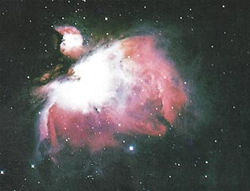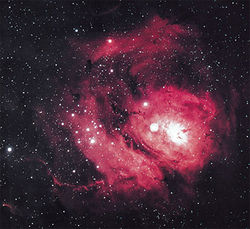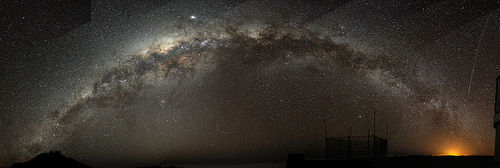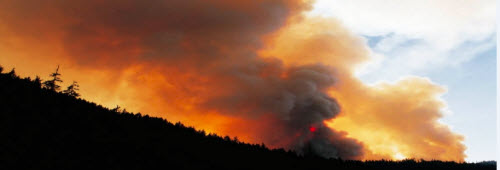Qur'an and a Universe from Smoke
This article or section is being renovated. Lead = 1 / 4
Structure = 3 / 4
Content = 4 / 4
Language = 2 / 4
References = 2 / 4
|
This article analyzes the apologetic claim that the Qur'an contains an accurate account of the formation of stars and early phases of the Universe. ==Introduction==
Prominent apologists such as Harun Yahya and I. A. Ibrahim have claimed that the Qur'an contains an accurate account of the formation of stars and early phases of the Universe. This claim has been widely disseminated and repeated on numerous websites without any critical examination. The basis of the claim is a verse found in Surah Fussilat (Signs Spelled Out), the 41st Surah of the Qur'an which says that the "heavens" were once smoke. Apologists argue that this information about the early universe could not have been known in 7th century Arabia and has only come to light in the 20th and 21st centuries through modern scientific investigation.
===Modern Cosmology===
Before evaluating the claim of a miracle, it is important to have an accurate understanding of modern cosmology. In the 20th and 21st century, theoretical physicists and cosmologists have given detailed models for the formation of the early universe, stars, galaxies, and planets. These models, often referred to as the Big Bang theory and the Nebular hypothesis, are widely supported by the scientific community.[1][2]
In the initial expansion of the early Universe, all that existed was a dense, hot, mass of energy. As the Universe rapidly increased in size, light chemicals like hydrogen and helium began to form. For the first 380,000 years, the intense heat made it too hot for light to shine. Atoms would bump into each with enough force to break up into a dense, opaque plasma of protons, neutrons and electrons; this dense mass prevented any photons from escaping. After this phase, the universe expanded and cooled enough for electrons to combine with protons to form the first real elements. At this point, photons could move freely, and the first light could be seen.[3]
This smooth, nearly featureless plasma of hydrogen and helium continued to cool and expand until small imperfections formed. Then gravity drew the particles together to form the earliest stars. This evolution of the universe continued to increase the contrast of the matter distribution to create the intricate collection of galaxies, stars, and nebulae observed in the night sky today.[4]
In the hot and dense cores of stars, heavier elements such as carbon, oxygen, nitrogen and iron formed. When these stars would novae (i.e. explode) they would scatter these heavier elements as debris across vast stretches of inter-stellar space. Eventually, gravity from other stars would pull this debris together to form planets like the ones in the solar system today.[5]
==Apologetic Claim==
Figure 1: A new star forming out of a cloud of gas and dust (nebula), which is one of the remnants of the ‘smoke’ that was the origin of the whole universe. (The Space Atlas, Heather and Henbest, p. 50.)
Figure 2: The Lagoon nebula is a cloud of gas and dust, about 60 light years in diameter. It is excited by the ultraviolet radiation of the hot stars that have recently formed within its bulk. (Horizons, Exploring the Universe, Seeds, plate 9, from Association of Universities for Research in Astronomy, Inc.)
The illuminating stars we see at night were, just as was the whole universe, in that ‘smoke’ material. God has said in the Quran:
:“Then He turned to the heaven when it was smoke...” (Quran 41:11)
Because the earth and the heavens above (the sun, the moon, stars, planets, galaxies, etc.) have been formed from this same ‘smoke,’ we conclude that the earth and the heavens were one connected entity. Then out of this homogeneous ‘smoke,’ they formed and separated from each other. God has said in the Quran:
:“Have not those who disbelieved known that the heavens and the earth were one connected entity, then We separated them?...” (Quran 21:30)
Dr. Alfred Kroner is one of the world’s renowned geologists. He is Professor of Geology and the Chairman of the Department of Geology at the Institute of Geosciences, Johannes Gutenberg University, Mainz, Germany. He said: “Thinking where Muhammad came from . . . I think it is almost impossible that he could have known about things like the common origin of the universe, because scientists have only found out within the last few years, with very complicated and advanced technological methods, that this is the case.” Also he said: “Somebody who did not know something about nuclear physics fourteen hundred years ago could not, I think, be in a position to find out from his own mind, for instance, that the earth and the heavens had the same origin.”I. A. Ibrahim, Islam-Guide, accessed December 19, 2013, http://www.islam-guide.com/islam-guide.pdf.
==Analysis==
===Definition of Smoke===
Since the entire argument rests on the Qur'anic description of the "heavens" as "smoke", it is claimed this word is the best possible way to describe the early Universe:
Harun Yahya, Miracles of the Qur'an, accessed December 19, 2013, http://www.miraclesofthequran.com/scientific_04.html.
This claim is based on a logical fallacy; a false equivalence between "smoke" and their definition of the early universe: "an opaque highly dense and hot gaseous composition" or just "hot gas". The actual definition of smoke is presented below:
:the cloud of black, gray, or white gases and dust that is produced by burning something.
. . .
There is no similarities between the early universe and smoke. There was no burning of material, especially of organic compounds in the early universe. Organic molecules would not exist for another 10 billion years. Even carbon did not exist at this stage and it would not exist for millions of years until it was first fused in the center of giant stars. The early universe was extremely dense and smoke is not dense at all; in fact smoke is completely vaporous. Smoke can be hot, but often is not. It is the hot gas close to the burning material that can make smoke hot, but the carbon particles that linger in the air can be quite cool.
===Single-Word Description===
The claim presupposes that the Qur'anic author must describe the earliest phase of the universe using a single word. However, no one would be convinced if a scientist, purporting to be an expert in cosmology, put together a paper on the formation of stars and only described it in a single word. Even apologists realize that a single-word description is not adequate to convey such a complex topic, which is why they use multiple words to describe this state of the universe and even a short paragraph to make their point. One has to wonder why the Qur'anic description is so sparse and inadequate given how easy it would have been for Allah to have conveyed such information.
This lack of detail is further highlighted by the depth and number of words used by the author of the Qur'an on other topics. The author explains in detail who you can and cannot marry and how an inheritance can be divided. The Qur'an also retells stories multiple times. Based on these facts, it is difficult to rationalize why such sparse details were used to describe something as complex as the formation of the universe, especially when such information could have validated the authenticity of the Qur'anic message.
===Nebulea and Milky Way===
The claim then makes use of images of distant nebulae only visible through the aid of modern telescopes. These wispy, red and pink clouds of hydrogen gas are supposed to provide a visual connection to smoke. In the absence of other imagery, one might make the mental connection. However, smoke is a thick, billowing substance that is always black, gray, or white. Given this fact, another image of the night sky is far more reminiscent of smoke than the distant nebulae above, and it can be seen with the naked eye right here on earth. It does not require divine revelation nor advanced scientific instruments to imagine the Milky Way as a cloud of smoke in the night sky. It is easy to see how someone in the 7th century looking up from the desert could have invented this myth.
===Qur'anic Verse in Context===
After a description of the hot, dense, plasma of the early universe as "smoke" and the use of images of distant nebulae, it is then shown that the Qur'an is describing this early phase of the universe:
:“Then He turned to the heaven when it was smoke...” (Quran 41:11)
Because the earth and the heavens above (the sun, the moon, stars, planets, galaxies, etc.) have been formed from this same ‘smoke,’ we conclude that the earth and the heavens were one connected entity. Then out of this homogeneous ‘smoke,’ they formed and separated from each other. God has said in the Quran:
:“Have not those who disbelieved known that the heavens and the earth were one connected entity, then We separated them?...” (Quran 21:30)
However, the entire Qur'anic verse nor any of the surrounding verses are quoted. Here is the verse, in its proper context:
10. He placed therein firm hills rising above it, and blessed it and measured therein its sustenance in four Days, alike for (all) who ask;
11. Then turned He to the heaven when it was smoke, and said unto it and unto the earth: Come both of you, willingly or loth. They said: We come, obedient.
12. Then He ordained them seven heavens in two Days and inspired in each heaven its mandate; and We decked the nether heaven with lamps, and rendered it inviolable. That is the measuring of the Mighty, the Knower.
In verses 9-10, the Qur'an states that Allah created the earth before he created the heavens. It provides a clear chronological account of the earth being formed first and then the hills and sustenance are created upon it. Only after the earth has been created does he look toward the heaven to create the stars. This is made apparent in the second half of verse 11 when Allah speaks to both the heaven and the earth; unless the earth had been created first, how could he speak to it? It is known from radiometric dating that the earth formed about 4.5 billion years ago, almost 9 billion years after the Universe first expanded.[7] The author of the Qur'an was not aware of this fact and claims that the earth and this "smoke" were in existence at the same time. In verse 12, the Qur'an says it is only then that the stars are created.
===Correct Arabic Word=== The Arabic word for "gas" is gaz or ghaz (غاز), not dukhan. It is this word which should have been used to describe the state of the universe if the above verse were correct.
===Support from Scientists===
The final piece of evidence is the claim that a renowned geologist supports the view that the information in the Qur'an could not have been of human origin:
While Dr. Alfred Kroner was a geology professor in Germany, he never endorsed the Qur'an as being an accurate source of scientific information. A video interview conducted with Kroner in 2011 confirms that his comments from the 80s were taken out of context.[8] He currently does not endorse the Qur'anic view of creation nor did he at the time of the original interview. He affirms that parts of the Qur'an are not supported by modern scientific evidence and are completely unscientific and mythical.
==Conclusion==
The entire argument rests on the Qur'anic description of the "heavens" as "smoke"; a claim which in-turn rests on a false equivalence made between smoke and the makeup of the early universe. It also presupposes that the Qur'anic author must describe something as complex as the earliest phase of the universe using only a single word. A presupposition that makes little sense and is far from convincing when you consider how such information could have validated the authenticity of the Qur'anic message.
The attempt to show that the Qur'an correctly describes the formation of stars (by quoting a portion of Qur'an 41:11) and then the earth (by quoting Qur'an 21:30) is shown to be disingenuous. When the whole of verse 41:11 and its surrounding verses are read in context, it provides a clear chronological account of the earth being formed first and then the hills and sustenance are created upon it. Only after the earth has been created does Allah create the stars. The entire account in the Qur'an is not an accurate reflection of the formation of the Universe.
Then there is the use of images of distant nebulae only visible through the aid of modern telescopes that are meant to provide a visual connection to smoke. However, it does not require divine revelation nor advanced scientific instruments to imagine the Milky Way, something that can be seen with the naked eye right here on earth, as a cloud of smoke in the night sky.
Finally, in an attempt to provide some much needed credibility, the apologist makes an appeal to authority by claiming that a renowned geologist supports their views, when in fact he has never endorsed the Qur'an as being an accurate source of scientific information and was simply quote mined.
==See Also==
*Scientific Miracles in the Quran
- Creation - A hub page that leads to other articles related to Creation
- I. A. Ibrahim - A hub page that leads to other articles related to I. A. Ibrahim
==External Links==
*Does Science really prove the Quran? Heavens created as 'Smoke' - , Answer-Islam ([http://www.webcitation.org/query?url=http%3A%2F%2Fwww.answer-islam.org%2FSmoke.html&date=2013-12-18 archived]), http://www.answer-islam.org/Smoke.html
==References==
- ↑ Abby Cessna, "How Was the Solar System Formed ", Universe Today, August 23, 2009 ([http://www.webcitation.org/query?url=http%3A%2F%2Fwww.universetoday.com%2F38118%2Fhow-was-the-solar-system-formed%2F+&date=2013-12-20 archived]), http://www.universetoday.com/38118/how-was-the-solar-system-formed/.
- ↑ Yuki D. Takahashi, "Big Bang: How Did the Universe Begin?", California Institute of Technology , Spring 2000 ([http://www.webcitation.org/query?url=http%3A%2F%2Fwww.ugcs.caltech.edu%2F%7Eyukimoon%2FBigBang%2FBigBang.htm+&date=2013-12-20 archived]), http://www.ugcs.caltech.edu/~yukimoon/BigBang/BigBang.htm.
- ↑ Denise Chow, "The Universe: Big Bang to Now in 10 Easy Steps", SPACE.com , October 18, 2011 ([http://archive.is/gmEOH archived]), http://www.space.com/13320-big-bang-universe-10-steps-explainer.html .
- ↑ Sean Carroll, "Cosmology Primer: The Early Universe", Preposterous Universe , accessed December 20, 2013 ([http://archive.is/HMAa5 archived]), http://preposterousuniverse.com/writings/cosmologyprimer/early.html .
- ↑ Space Telescope Science Institute, "How do Planets Form", HubbleSite, accessed December 20, 2013 ([http://archive.is/ZOyre archived]), http://hubblesite.org/hubble_discoveries/discovering_planets_beyond/how-do-planets-form.
- ↑ , "Smoke", Merrian-Webster, accessed December 19, 2013 ([http://www.webcitation.org/query?url=http%3A%2F%2Fwww.merriam-webster.com%2Fdictionary%2Fsmoke&date=2013-12-19 archived]), http://www.merriam-webster.com/dictionary/smoke.
- ↑ "Age of the Earth ", U.S. Geological Survey, July 9, 2007 ([http://www.webcitation.org/query?url=http%3A%2F%2Fpubs.usgs.gov%2Fgip%2Fgeotime%2Fage.html&date=2013-12-19 archived]), http://pubs.usgs.gov/gip/geotime/age.html.
- ↑ TheRationalizer, "Alfred Kröner - Quote mined scientist denounces Quran miracle claims", YouTube (video), March 21, 2011 ([ archived]), http://www.youtube.com/watch?v=ClHuG880pqU.



